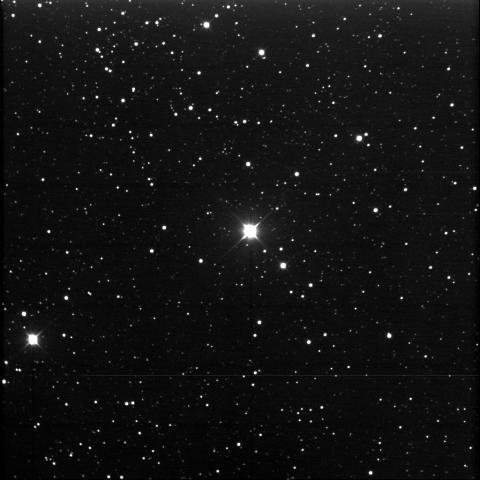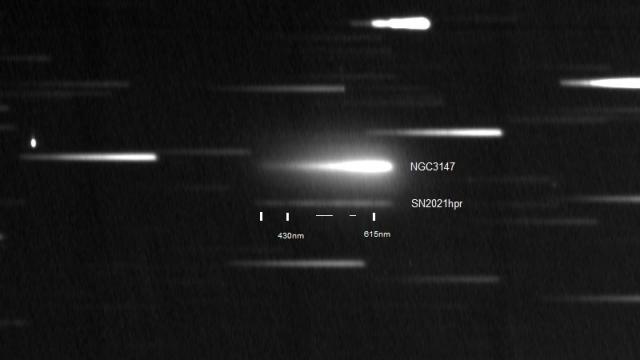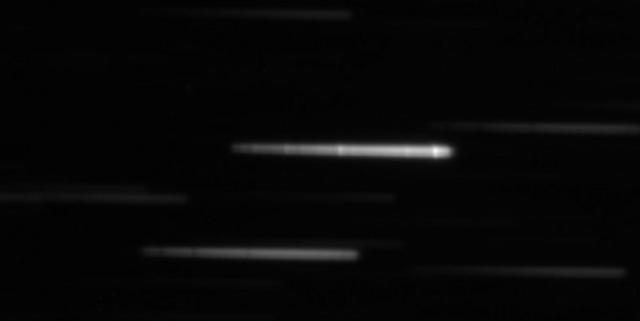Forum Replies Created
-
AuthorPosts
-
 Mike HarlowSpectator
Mike HarlowSpectatorThanks Nick, very nice video! Picks up the fact that some satellites were on slightly different paths (slightly north or south) as Stan noted earlier.
Mike.
 Mike HarlowSpectator
Mike HarlowSpectatorThanks Stan et. al. good to see you got some images of the event. I should have realised that meteor cameras would be picking these things up all the time.
I’m reliably informed that the pass included Starlink 2261 which passed through Delphinus at 01:07 from my site in Suffolk.
Thanks again for everyone’s feedback; they are interesting events to witness if somewhat disturbing for deep sky imagers.
Mike.
 Mike HarlowSpectator
Mike HarlowSpectatorThanks Hugh, that’s a really interesting summary of recent changes…I’m glad I was seeing something real! It will be fascinating to see what it does next…
Mike.
 Mike HarlowSpectator
Mike HarlowSpectatorI’m still taking spectra of the nova whenever possible and the latest one from last night seems to suggest that the helium lines are coming back. Can anyone confirm this? I’m no expert on novae but I can’t remember seeing one like this before. Can anyone explain what it’s doing and has this sort of behaviour been seen before? And it appears to be creeping up in magnitude again!
Thanks,
Mike.
 Mike HarlowSpectator
Mike HarlowSpectatorIdeal conditions last night to try for a higher res. spectrum; no wind and low humidity. The result is on my members page and shows some nice detail at the blue end of the spectrum.
Mike.
 Mike HarlowSpectator
Mike HarlowSpectator
An image from 23:30UT last night (10th)…nova at centre of 25 x 25 arc minute frame, north up. It may seem like overkill to image a mag 5.3 nova with a 30cm telescope (!) but I’ll be able to follow it as it fades back to mag 18,19 or less with the same set-up. Should make a nice sequence…maybe even an animation…!?
I did look but couldn’t see it naked-eye. But it was very nice through binoculars and the 4 inch F/5 finderscope on the main telescope.
Mike.
 Mike HarlowSpectator
Mike HarlowSpectatorHi Hugh,
Wow…that’s a really nice spectrum! I’m impressed that you got such a nice result from the .jpg without even seeing the .fts file. Anyway, it does show one thing…I need to get to grips with some spectroscopy software to produce some more useful results.
You’re right that the red end is saturated as it’s difficult to get the exposure right to show both ends correctly exposed, especially for red objects.
Some background on the prism. It was instrument no. 179 in the BAA instrument collection and I took it out on loan in 2012. Thanks to Bob Marriott for organising the loan and even delivering it in person! I purchased it from the BAA a few years back when the instrument collection was finally sold off. Apparently it has been used by some famous names in the past including Mike Hendrie and David Sinden. But most notably it was used in the 1980s and 1990s by Maurice Gavin for much of his pioneering work on spectroscopy with film and CCDs. This work was published in the BAA Journal in 1996: ‘Stellar spectroscopy with CCDs-some preliminary results’. J. Br. Astron. Assoc. 106(1) 1996, p11-15.
It may be old technology but as you’ve shown it can still produce useful spectra. And given it’s history I feel I should keep using it as long as I can.
Thanks for taking the time to analyse my spectrum…I must make more effort!
Mike.
 Mike HarlowSpectator
Mike HarlowSpectatorLuckily I was out last night (7th) taking another spectrum of the nova but with slightly better resolution. As soon as I found the field in the finderscope it was obvious the nova had brightened significantly. The spectrum now shows very well defined P-Cygni features on most of the emission lines.
Astronomer’s telegram ATel14614 gives a nice update on the nova’s evolution.
 Mike HarlowSpectator
Mike HarlowSpectatorHi Robin,
I did try a transmission grating spectrum this morning just for fun. Maybe shows the image of the tail in sodium light??? A bit faint but I’ll try again next time I get the chance. Larger image on my members page,
Mike.
Details: Thor labs 300l/mm transmission grating in front of 55mm lens on un-modified Canon 550D DSLR.
 Mike HarlowSpectator
Mike HarlowSpectatorHi Hugh,
Thanks for the info, that’s very useful.
And I must say your animations of the changing spectrum are fascinating to watch. Really excellent work and thanks for sharing them on your members page.
Mike.
 Mike HarlowSpectator
Mike HarlowSpectatorHi Robin,
Thanks for the information, that’s very useful,
Mike.
 Mike HarlowSpectator
Mike HarlowSpectatorHi Hugh,
A link to the BAA database would be useful for those of us who haven’t used it. That’s what I like about ARAS, all the spectra are easily visible to anyone…plus they are stored in a database for scientific research by the specialists.
And that’s a very nice spectrum…a full sized version on your members page would be good.
Thanks,
Mike.
 Mike HarlowSpectator
Mike HarlowSpectatorA recent Astronomer’s telegram, ATel 14577, details changes in the spectrum with the emergence of iron lines. Lots of spectra on the ARAS web site show these lines developing with He I lines fading.
The He I lines labelled in my low res spectrum from 23rd April may actually be Fe II instead… More spectra planned when the skies clear again…
 Mike HarlowSpectator
Mike HarlowSpectatorI’ve attached my recent objective prism spectrum not because it shows anything new but to illustrate a trick used for line identification. (Taken on 12th April 2021).

I usually image and take spectra through an Astrodon luminance filter which has a sharp cut-off at 700nm. The result is that all spectra cut-off at that wavelength giving an internal reference on all the spectra in the field. Coupled with the dispersion equation for the prism this enables reasonable estimates for line positions. In the spectrum of SN2021hpr the first absorption below 700nm is the Si II line as shown nicely in Kevin Gurney’s spectrum (of another type-Ia SN) and those above.
I can’t claim any originality here, this was a trick used by professional astronomers conducting objective prism surveys in the 1960s, 70s and 80s. Some of the photographic plates used had sharp spectral cut-offs imprinting a known wavelength on their spectra. And when you have a Schmidt photographic plate with 1000s of spectra on it that’s really useful!
 Mike HarlowSpectator
Mike HarlowSpectatorTaking a closer look at my image from 19th March I just got the Bubble nebula at the edge of the field. Image on my members page: V1405 Cas and the Bubble nebula.
Mike.
 Mike HarlowSpectator
Mike HarlowSpectatorQuick look low resolution spectrum. Reveals a bright continuum with strong hydrogen emission lines and some other as yet unidentified emission lines. Field is 12 x 6 arc minutes and conveniently includes an ‘ordinary’ A-type star spectrum for comparison(!) with hydrogen absorption lines. Taken with a 26cm, 3 degree objective prism on a 12inch F/3.6 astrograph. 24 x 20 seconds. 19th March 2021 at ~21:00GMT.

 Mike HarlowSpectator
Mike HarlowSpectatorA modest 56 nights of imaging from home in 2020 with a hand full of remote telescope sessions. My main targets are variable nebulae with the majority of images being of Gyulbudaghian’s nebula which had a dramatic fade. A remote image of McNeil’s nebula showed that it was still invisible and Hind’s nebula showed little change in shape.
Two novae appeared that were initially bright enough for both imaging and low resolution spectroscopy. Nova Cas 2020 has now undergone a deep dust fade but may well brighten again in the next few months. Nova Persei remains bright enough for spectroscopy and should be interesting to watch as it fades in the next few months.
And there was that comet…NEOWISE. I don’t have the technology or skill to get stunning images but a simple set-up did reveal the sodium tail early in the apparition.
Looking forward to seeing how some of these objects change in 2021.
Mike.
 Mike HarlowSpectator
Mike HarlowSpectatorImaged the nova last night and it is barely detectable now. Presumably if it does behave like DQ Her it should brighten again in the next month or so? Well worth keeping an eye on…!
Mike
 Mike HarlowSpectator
Mike HarlowSpectatorRecent Astronomers telegrams report that dust formation is happening in this nova explaining the recent deep fade. See ATel14272 and ATel14267 for details. Also recent images illustrating the fade are on my members page.
14 December 2020 at 11:14 am in reply to: Gyulbudaghian’s Nebula imaged on two nights in mid November 2020 #583560 Mike HarlowSpectator
Mike HarlowSpectatorHi Mike,
Nice images, as Grant says, please keep imaging this nebula, changes can happen on short timescales so the more coverage we have the better.
I image it as often as possible and have observations from 5th and 19th November which show a similar feature to the one you are seeing. I put all my images on my members page. See these two for direct comparison: 5th November, 19th November.
All the best,
Mike.
-
AuthorPosts
